Examining the Location Characteristics of Knowledge Industrial Space for Smart Planning and Industry 4.0: A Case Study of Hangzhou, China
Abstract
:1. Introduction
2. Study Site and Data Sources
2.1. Study Site
2.2. Conceptual Connotation
2.2.1. Knowledge Industry
2.2.2. Knowledge-Oriented Talents
2.2.3. Urban Amenity
2.3. Data Processing
2.4. Method
2.4.1. Nearest Neighbor Index
2.4.2. Kernel Density Estimation
2.4.3. Multivariate Linear Regression
3. Results
3.1. Characteristics of the Spatial Structure of Knowledge Industries
3.2. Spatial Location Characteristics of Knowledge Industries
3.2.1. Overall Spatial Location Characteristics of Knowledge Industries
3.2.2. Spatial Location Characteristics of Different Types of Knowledge Industries
3.3. Influencing Factors of Knowledge Industrial Location
4. Discussion
4.1. Spatial Location Characteristics of Knowledge Industries
4.2. Influencing Factors of Knowledge Industrial Location
4.3. Policy Implications
4.4. Limitations and Further Study
5. Conclusions
Author Contributions
Funding
Institutional Review Board Statement
Informed Consent Statement
Data Availability Statement
Acknowledgments
Conflicts of Interest
References
- Yonghui, L.; Bolan, S.; Shun, H.; Sen, L. The spatial effect of producer services agglomeration and urban technological innovation-an empirical analysis based on the panel data of 108 cities in the Yangtze River Economic Belt. Econ. Geogr. 2021, 41, 65–76. [Google Scholar] [CrossRef]
- Fan, X.; Jianzao, R.; Mindong, W.; Tianhui, L.; Wenying, F. Spatial and temporal distribution and influence mechanism of Chinese high-tech enterprises since the 21st century. Econ. Geogr. 2018, 38, 27–35. [Google Scholar] [CrossRef]
- Zhiqiang, W.; Jian, W.; Deren, L.; Lieyun, D.; Anrong, D.; Feng, Z.; Tao, Y.; Helin, L.; Junyan, Y.; Ying, L.; et al. The “cold” thinking under the boom of smart city academic writing. J. Urban Plan. 2022, 2, 1–11. [Google Scholar] [CrossRef]
- Honghui, Z.; Liang, H.; Siqi, T. Thinking about the Transformation of Urban Governance Model in the Context of Epidemic: Exploring the Logic, Concept and Path of “Dual Intelligence Synergy” Construction of Smart Planning and Smart City. China Urban Planning. 2020. Available online: https://mp.weixin.qq.com/s/MaKWBAPhn04JujRoYyF24g (accessed on 16 October 2022).
- Feng, Z.; Yu, K. A framework for “people-technology-space” integrated smart city planning. J. Urban Plan. 2021, 45–52. [Google Scholar] [CrossRef]
- Yang, W.; Ren, Y.; Qiang, L.; Xi, W. Spatial layout characteristics and patterns of Guangzhou banking industry. Geogr. Sci. 2016, 36, 742–750. [Google Scholar] [CrossRef]
- Ruogu, Y. A Study on the Spatial Divergence of Synergistic Agglomeration in the Financial Industry—An Observation Based on the Site Selection of Financial Enterprises in Shenzhen. Guangdong Soc. Sci. 2021, 5, 26–35. [Google Scholar]
- Min, X.; Hongyan, Z.; Nana, Z.; Yuanjun, Z. Spatial pattern evolution and location selection of software industry in Ningbo. Econ. Geogr. 2017, 37, 127—134+148. [Google Scholar] [CrossRef]
- Jinlei, G.; Huiming, Z. Spatial pattern evolution and location selection of software and information technology service enterprises in Chongqing’s main urban area. Trop. Geogr. 2021, 41, 1270–1279. [Google Scholar] [CrossRef]
- Chengjun, L.; Zhouyuanye, W.; Xushuang, L.; Jianping, Z.; Jianhua, J.; Hehong, H. Spatial Pattern Evolution and Location Choice of Internet Start-ups—Hangzhou as an Example. Econ. Geogr. 2021, 41, 107—115+146. [Google Scholar] [CrossRef]
- Lin, G.C.S.; Yang, F.F.; Hu, F.Z.Y. The new geography of information and consulting services in China: Comparing Beijing and Guangzhou. Habitat Int. 2012, 36, 481–492. [Google Scholar] [CrossRef]
- Dandan, W.; Renfeng, M.; Yue, Z.; Yixia, J.; Yiran, Z. Hangzhou Cultural and Creative Industry Agglomeration Characteristics and Spatial and Temporal Pattern Evolution. Econ. Geogr. 2018, 38, 127–135. [Google Scholar] [CrossRef]
- Ruzhong, C.; Yang, Z.; Yanlin, H.; Hua, G. Research on Spatial Agglomeration and Influence Effect of Cultural and Creative Industries in Yangtze River Delta Urban Agglomeration. Silk 2022, 59, 79–89. [Google Scholar]
- Florida, R. The Rise of the Creative Class: Revisited, 2nd ed.; Basic Books: New York, NY, USA, 2014; pp. 593–596. [Google Scholar]
- Aaron, S.D.; Nichols, C.T. Scenescapes:How Qualities of Place Shape Social Life; University of Chicago Press: Chicago, IL, USA, 2016; p. 2019. [Google Scholar]
- Grimes, A.; Badenhorst, S.; Maré, D.C.; Poot, J.; Sin, I. Quality of life, quality of business, and destinations of recent graduates: Fields of study matter. Ann. Reg. Sci. 2022, 7, 1–26. [Google Scholar] [CrossRef] [PubMed]
- Wei, C.; Rong, S.; Yongchao, Z.; Shihai, T. Research on performance evaluation of patent innovation in knowledge-intensive industries in China—Based on DEA-Malmquist index method. Manag. Rev. 2013, 25, 39—45+53. [Google Scholar] [CrossRef]
- Bing, S.; Jian, Z. Research on the diffusion and evolution of technological innovation in knowledge-intensive industries—from the perspective of network structure evolution analysis. J. Inf. 2013, 32, 198—203+184. [Google Scholar]
- Xiaoya, W.; Guoyang, W. Research on the synergy degree and influencing factors of knowledge-intensive industries. China Sci. Technol. Forum 2015, 47–53. [Google Scholar] [CrossRef]
- Peng, Y.; Xin, T.; Wenwu, P.; Huiqing, C. Research on the spatial association of potential innovation elements synergy and its relationship with the upgrading of high-tech industries in the Yangtze River Delta. Econ. Geogr. 2020, 1–14. Available online: http://kns.cnki.net/kcms/detail/43.1126.K.20200616.1623.002.html (accessed on 16 October 2022).
- Guangyu, L.; Zhongzhong, S.; Zijian, Z. Empirical test of the influencing factors of China’s high-tech industry innovation. Econ. Manag. Res. 2016, 37, 85–90. [Google Scholar] [CrossRef]
- Jinliao, H.; Gang, Z. Dynamic Mechanism of Creative Industry Agglomeration Driven by Urban Comfort—Taking Nanjing Brand Design Industry as an Example. Econ. Geogr. 2019, 39, 134—142+161. [Google Scholar] [CrossRef]
- Feilong, H.; Yuxin, Y.; Shijun, W. Spatial characteristics and influencing factors of innovation output in Changchun from the perspective of urban comfort. Hum. Geogr. 2020, 35, 61—68+129. [Google Scholar] [CrossRef]
- Yue, W. Does the flow of R&D elements promote the spatial convergence of regional innovation quality-from the perspective of urban comfort. J. Beijing Inst. Technol. 2021, 23, 62–70. [Google Scholar] [CrossRef]
- Chang, L.; Yingjie, Y.; Hui, L. The relationship between urban comfort, difference and innovation ability in Beijing. Geogr. Sci. 2022, 42, 115–125. [Google Scholar] [CrossRef]
- Jiang, X.; Fu, W.; Li, G. Can the improvement of living environment stimulate urban Innovation?—Analysis of high-quality innovative talents and foreign direct investment spillover effect mechanism. J. Clean. Prod. 2020, 255, 120212. [Google Scholar] [CrossRef]
- Dong, P. Research on Innovation and Development of Digital Economy Empowerment Strategic Emerging Industry. Theor. Discuss. 2022, 168–172. [Google Scholar] [CrossRef]
- Yingjie, R.; Jianguo, D.; Xia, Z. Innovation—Research on Employment under Industrial Upgrading. Sci. Manag. Res. 2022, 40, 83–90. [Google Scholar] [CrossRef]
- Bao, L. “Expertise and innovation” enterprises drive the construction of manufacturing power: Why is it possible and possible? Contemp. Econ. Manag. 2022, 44, 31–38. [Google Scholar] [CrossRef]
- Ling, N.; Yutong, S.; Chunyao, O. Analysis and Evaluation of Innovation Efficiency of Regional Marine High-tech Industry from the Perspective of Triple Helix Theory. Sci. Technol. Manag. Res. 2022, 42, 57–64. [Google Scholar]
- Naiquan, L.; You, W.; Guozhen, Z. The impact of specialized agglomeration and diversified agglomeration on regional innovation efficiency—An empirical analysis based on spatial Durbin model. Econ. Issues Explor. 2016, 2, 89–96. [Google Scholar]
- Wencheng, W.; Yuan, S. Research on the spatial effect of the collaborative agglomeration of producer services and high-tech industries on regional innovation efficiency. J. Manag. 2022, 19, 696–704. [Google Scholar]
- Qiang, Z.; Xia, D. Research on the Influence of Productivity Heterogeneity of Knowledge-intensive Service Industry. J. Henan Univ. 2022, 62, 21—27+152—153. [Google Scholar] [CrossRef]
- Jichuan, L. On Knowledge as the Power of Economic Growth. In Proceedings of the Documents of the Fourth National Congress of China Society of Dialectics of Nature, Beijing, China, 1 May 1996; pp. 70–73. [Google Scholar]
- Machlup, F. The Production and Distribution of Knowledge in the United States; Princeton University Press: Princeton, NJ, USA, 2007. [Google Scholar]
- Philip, C.; Andrea, P. Regional Development in the Knowledge Economy; Taylor and Francis: London, England, 2006; p. 2006. [Google Scholar]
- Peters, M.A.; Britez, R.; Bulut, E. Cybernetic capitalism, informationalism and cognitive labor. Geopolit. Hist. Int. Relat. 2009, 1, 11–40. [Google Scholar]
- Franke, S.; Kloosterman, R. Creativity and the City: How the Creative Economy Changes the City; NAi Publshers: Rotterdam, The Netherlands, 2006. [Google Scholar]
- Scott, A.J. Social Economy of the Metropolis: Cognitive-Cultural Capitalism and the Global Resurgence of Cities; Oxford University Press: Cary, NC, USA, 2008. [Google Scholar]
- Florida, R. High-Tech Dynamics. Science 1994, 264, 1614–1615. [Google Scholar] [CrossRef] [PubMed]
- Zheng, W.; Kejing, M.; Xiao, L.; Jingyuan, Z.; Shuling, X. Analysis of the location factors of the formation of high-tech industrial clusters. J. Geogr. 2005, 4, 567–576. [Google Scholar]
- Zahed, Y.; Hashem, D. How Do ICTs Affect Urban Spatial Structure? A Systematic Literature Review. J. Urban Technol. 2020, 27, 47–65. [Google Scholar]
- Song, Z.; Liu, W. The challenge of wide application of information and communication technologies to traditional location theory. J. Geogr. Engl. Ed. 2013, 23, 16. [Google Scholar] [CrossRef]
- Liu, J.; Feng, Z.; Shanqi, Z.; Yu, K.; Zhixuan, L. Spatial distribution characteristics and influencing factors of the new generation information technology enterprises in sss—A case study of downtown Nanjing. Econ. Geogr. 2022, 42, 114—123+211. [Google Scholar] [CrossRef]
- Chen, Y.; Rosenthal, S.S. Local amenities and life-cycle migration: Do people move for jobs or fun? J. Urban Econ. 2008, 64, 519–537. [Google Scholar] [CrossRef]
- Chengli, T.; Weiyang, C.; Jiamin, W.; Guohua, Z.; Meixia, W.; Xiashuang, G. Study on the Spatial Distribution and Industrial Aggregation Characteristics of Development Zones in Yangtze River Economic Zone. Geogr. Sci. 2020, 40, 657–664. [Google Scholar] [CrossRef]
- Yan, X.; Xuqiong, W.; Jun, X.; Shizhen, C. Analysis on the Spatial Distribution of Creative Industries and the Impact of Urban Location Function—A Case Study of Taichung City. Areal Res. Dev. 2022, 41, 52–58. [Google Scholar]
- Yarong, Z.; Renxu, G. Spatial pattern and influencing factors of digital creative listed companies in China. Geogr. Sci. 2022, 42, 1370–1380. [Google Scholar] [CrossRef]
- Qin, Y.; Xiaolei, X.; Senlin, H.; Gang, Z.; Jianlin, L. Spatial pattern and influencing factors of artificial intelligence industry in Yangtze River Delta. Resour. Environ. Yangtze River Basin 2022, 31, 526–536. [Google Scholar]
- Bing, Y.; Yan, Y. Stepwise regression analysis and its application. Stat. Decis. 2017, 14, 31–35. [Google Scholar] [CrossRef]
- Wentong, Z.; Wei, D. Advanced Course of SPSS Statistical Analysis; Higher Education Press: Beijing, China, 2013. [Google Scholar]
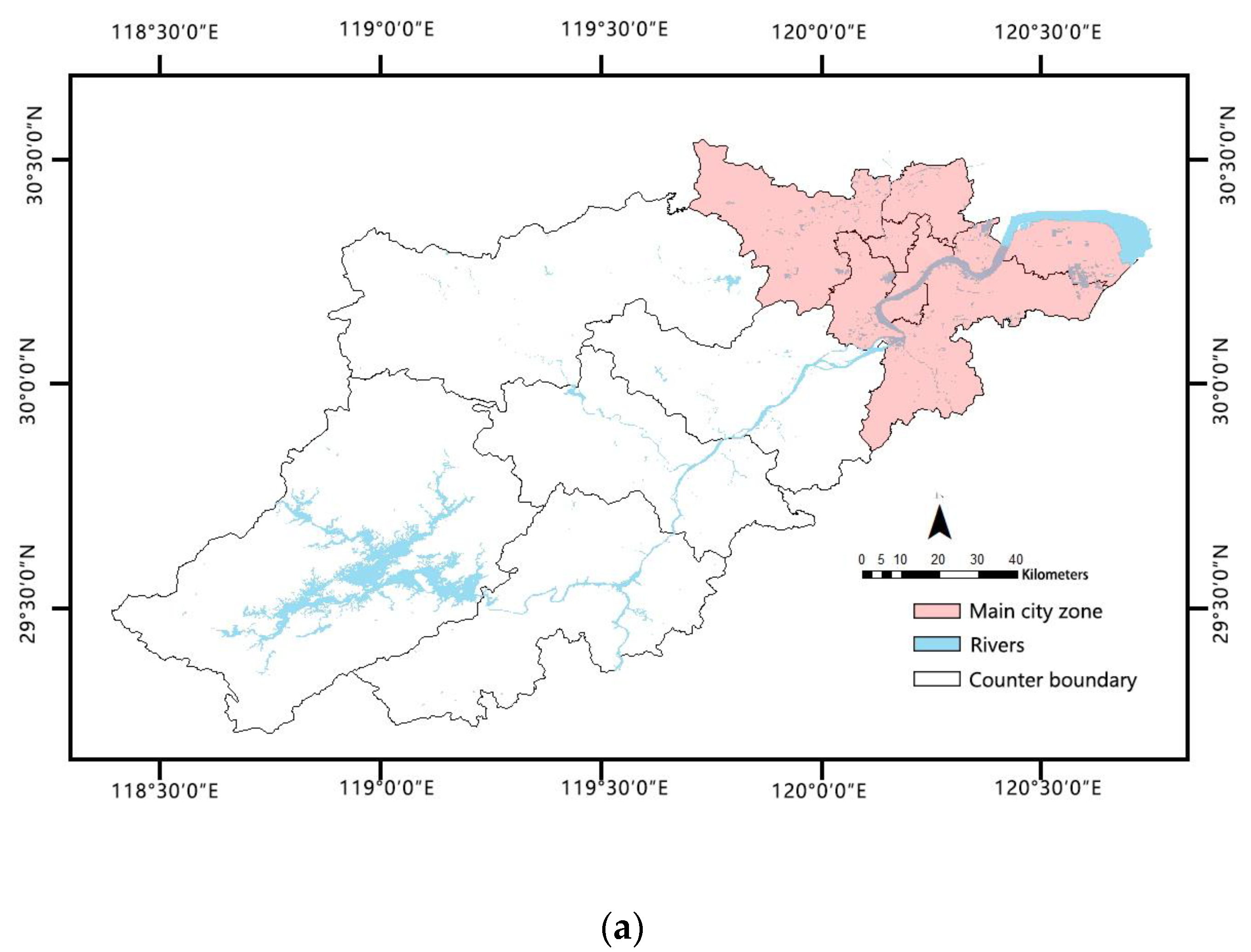
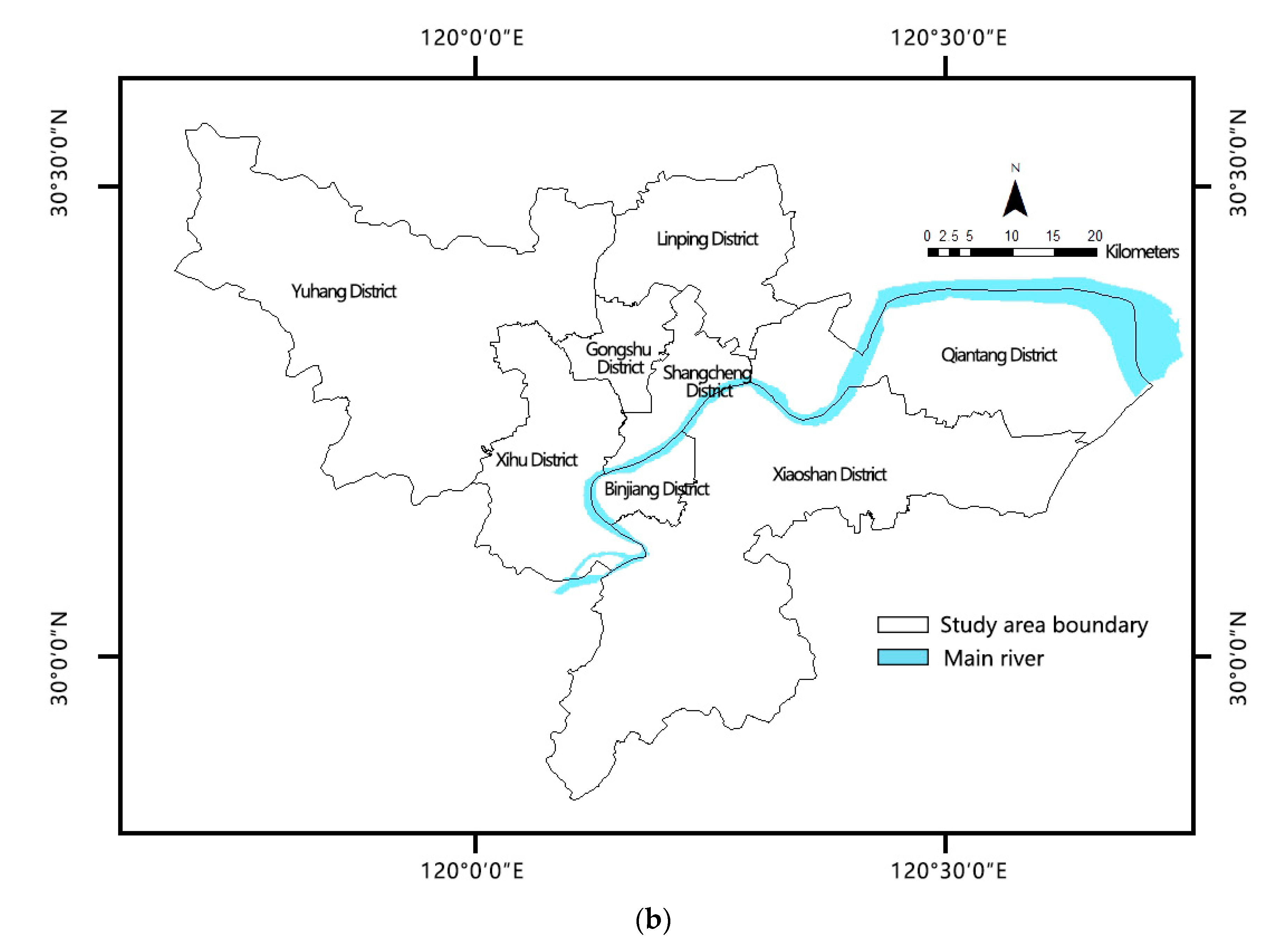
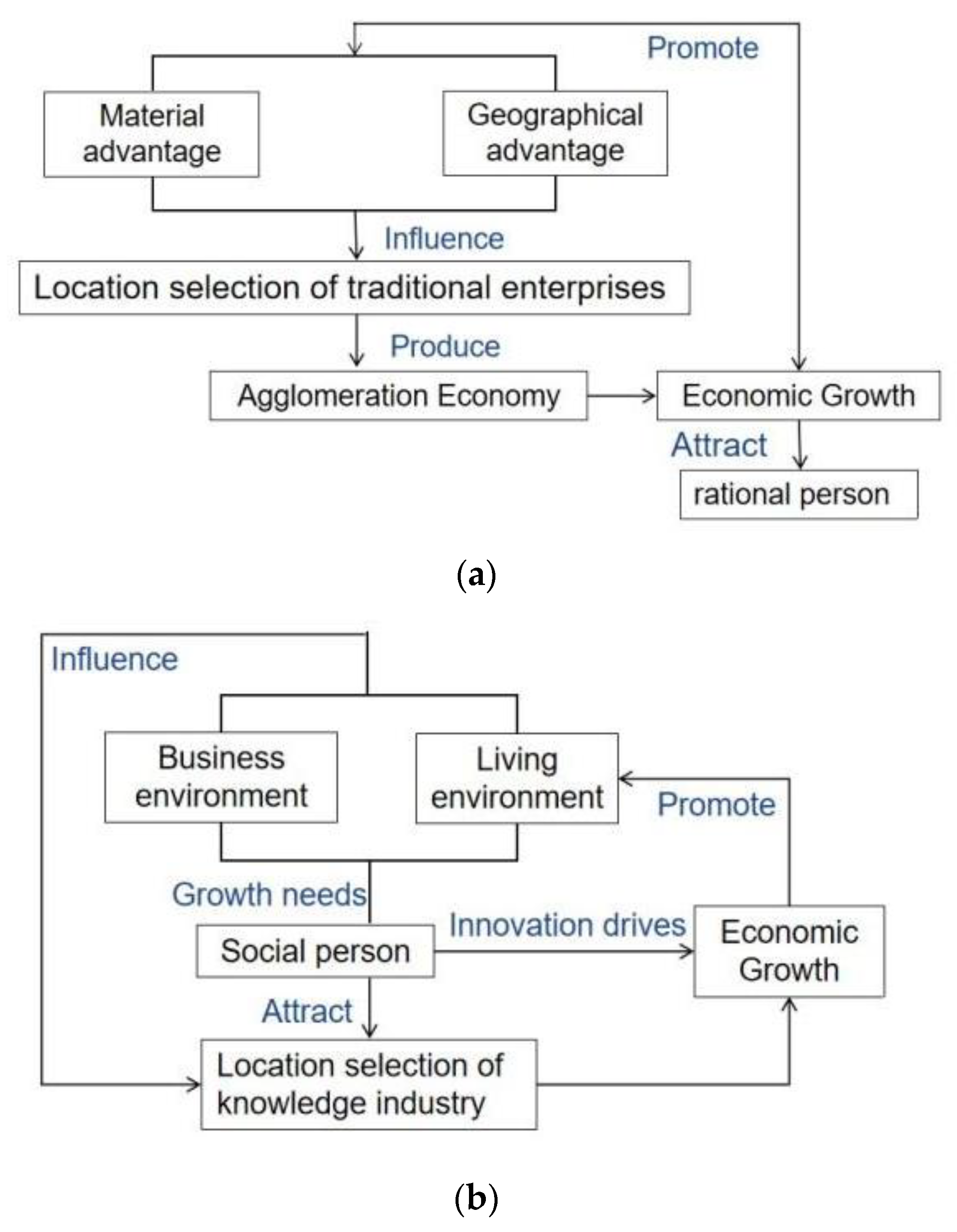
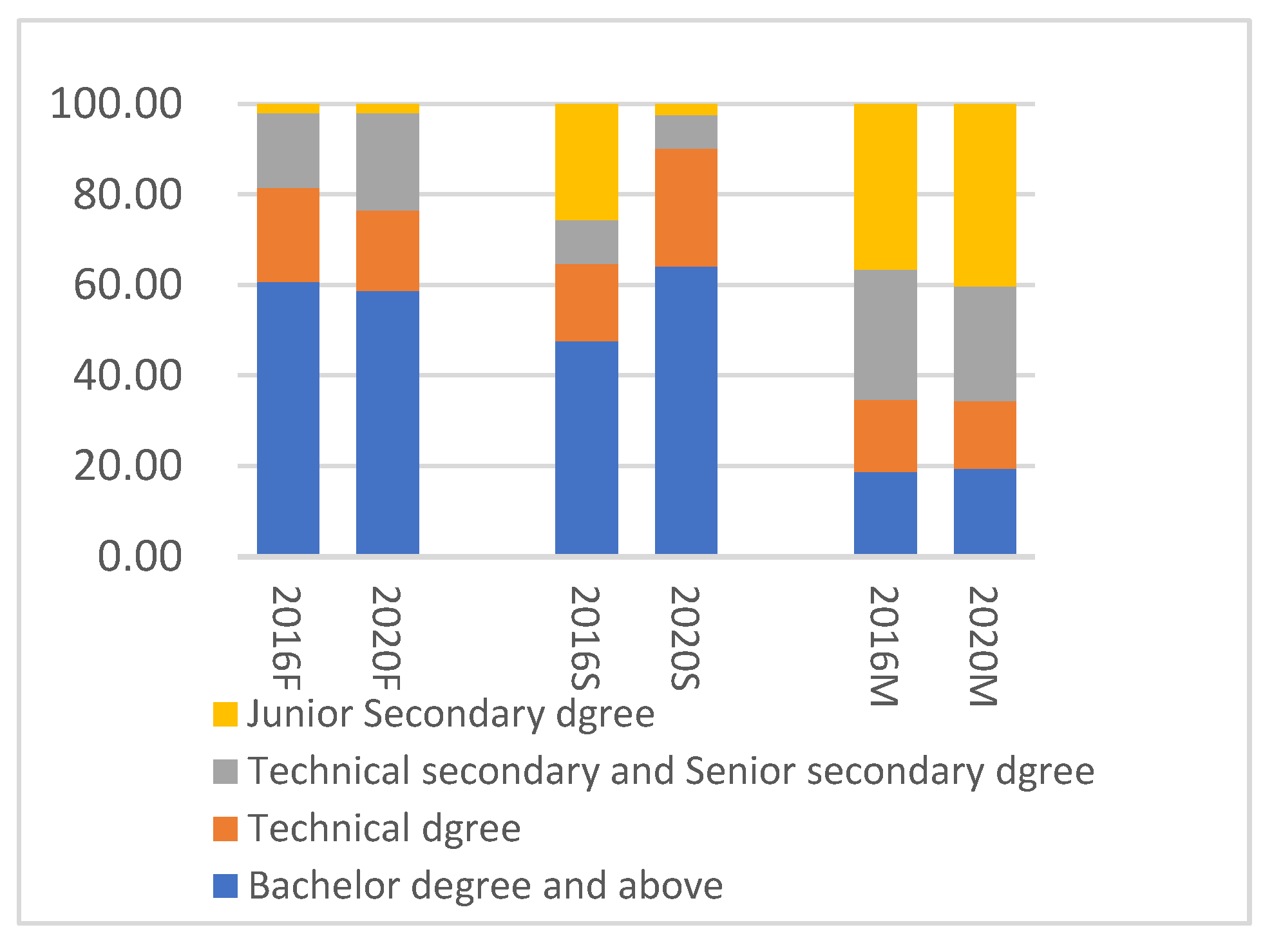
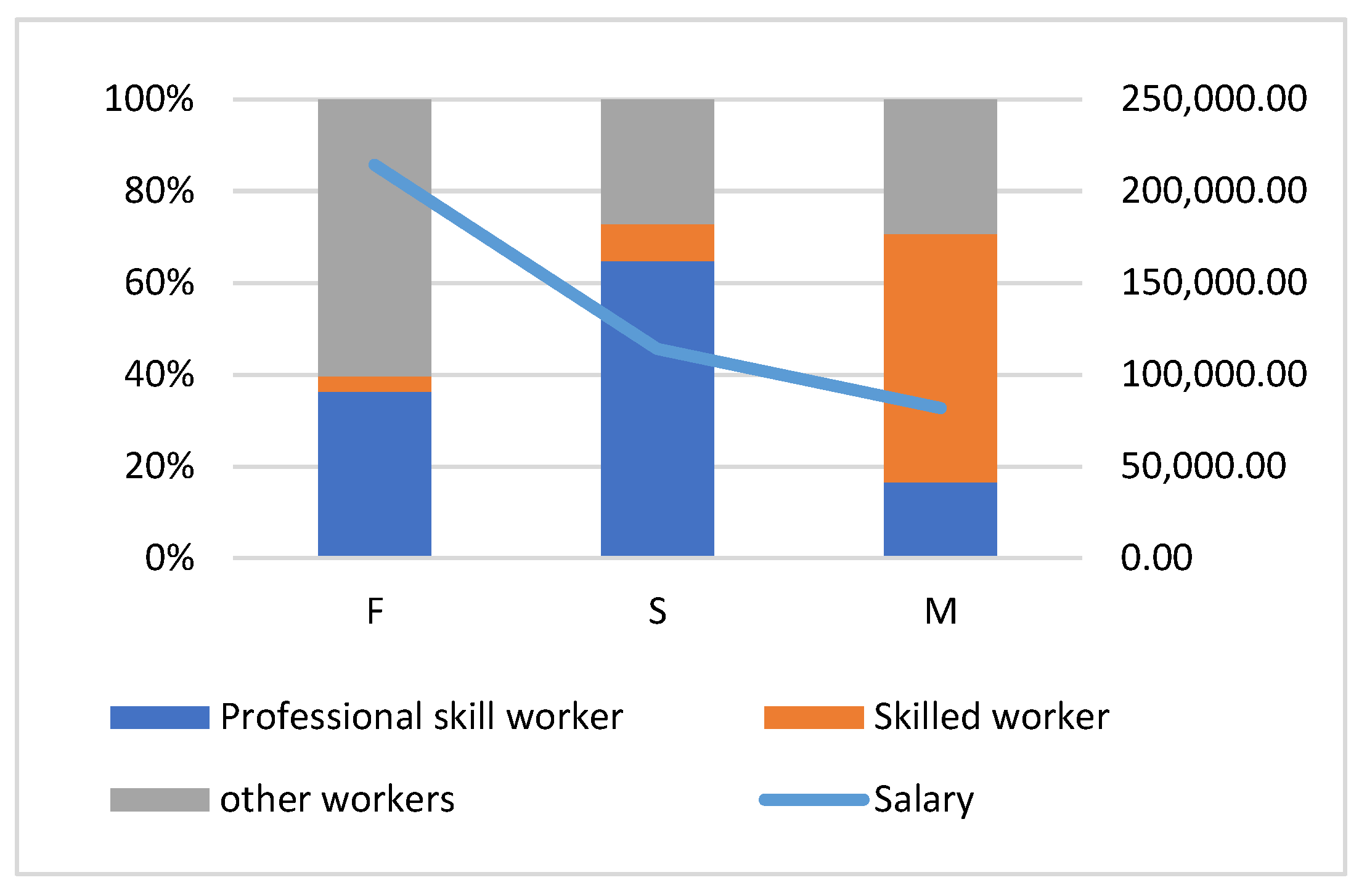
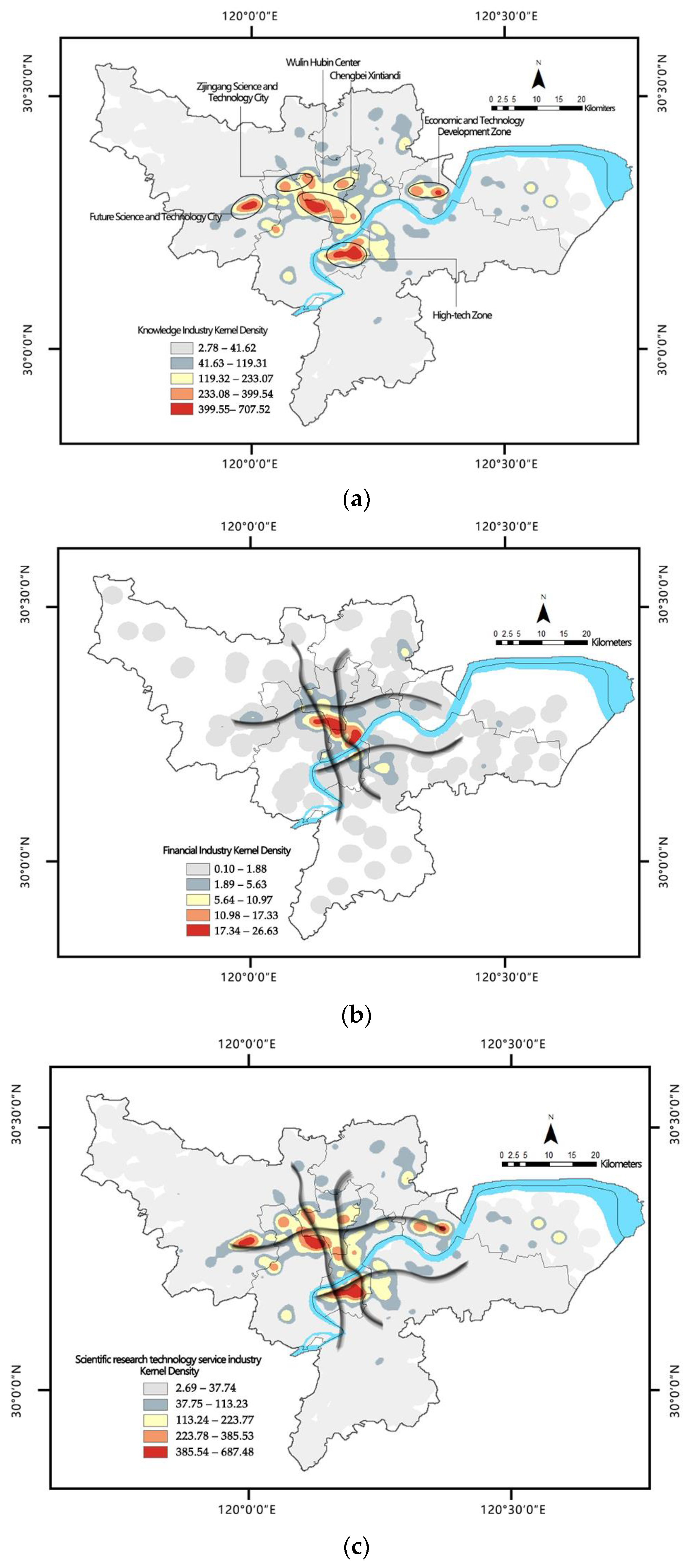

| Traditional Industry | Knowledge Industry | |
|---|---|---|
| Period | Industrial age, Industrial economy | Industry 4.0, knowledge economy |
| Factor of production | Labor, capital, raw materials | Human capital, technology |
| Product features | Mechanization, standardization | Intelligent, added value |
| Location selection factor | The location requirements of the industry itself | Location preference of knowledge talents |
| Influencing factors of employment | “Material and production”: that is, wages and rents are the main reasons that affect the flow of labor and capital | “Consumption and environment”: urban livability is the deep power that determines the spatial location of workers |
| Related theories | Industrial agglomeration theory, disequilibrium theory | Creative class theory, spatial equilibrium theory, scenes theory |
| Industry Name | Specific Subdivision | Numbers |
|---|---|---|
| Financial industry (F) | Financial services, capital market services, insurance, and other financial industries | 10,611 |
| Scientific research and technical service industry (S) | Research and experimental development, professional technical services, science and technology popularization, and application services. | 90,708 |
| Smart manufacturing industry (M) | Manufacturing, aviation, spacecraft and equipment manufacturing, electronic and communication equipment manufacturing, computer and office equipment manufacturing, medical equipment and instrumentation manufacturing, and information chemicals manufacturing. | 8726 |
| Primary Index | Secondary Index | Three-Level Index | Index Description |
|---|---|---|---|
| Business amenities | Traffic amenities | Subway stations | Density of subway stations |
| Bus station | Density of bus station | ||
| Parking lot | Density of parking lot | ||
| Educational amenities | Institutions of higher learning | The density of undergraduate, specialized, and junior colleges | |
| Research institute | Density of research institute | ||
| Landscape amenities | Park | Proportion of park area | |
| Square | Density of the square | ||
| Living amenities | Catering amenities | Café | Density of cafés |
| Snack bars | Density of snack bars | ||
| Service amenities | Shopping center | Density of department stores and supermarkets | |
| Beauty salon | Density of beauty, skin care, and barber shops | ||
| Recreational amenities | Fitness place | Gym, bowling, Taekwondo, tennis courts, and other densities | |
| Nightlife place | Density of KTV, bars, nightclubs, and music bars |
| Industry Type | Observation Distance (m) | Expected Distance (m) | NNI | Z Score | p Value |
|---|---|---|---|---|---|
| Knowledge industry | 9.69 | 126.37 | 0.08 | −549.22 | <0.01 |
| Financial industry | 57.96 | 418.72 | 0.14 | −63.31 | <0.01 |
| Scientific research and technical service industry | 54.19 | 332.33 | 0.19 | −179.46 | <0.01 |
| Smart manufacturing industry | 141.93 | 520.55 | 0.27 | −103.00 | <0.01 |
| Model | Variable | Model Parameter | |||||
|---|---|---|---|---|---|---|---|
| B | Beta | t | sig | VIF | |||
| (1) Financial industry | (Constant) | −0.569 | −2.713 | 0.008 | R2 = 0.923, Adjusted R2 = 0.922; F = 565.444; Durbin—Watson = 1.966 | ||
| Parking lot (X1) | 0.102 | 0.659 | 8.863 | 0 | 6.779 | ||
| Café (X2) | 0.297 | 0.318 | 4.276 | 0 | 6.779 | ||
Y = −0.569 + 0.102X1 + 0.297X2
| |||||||
| (2) Scientific research and technical service industry | (Constant) | 0.702 | 1.327 | 0.188 | R2 = 0.765, Adjusted R2 = 0.758; F = 101.020; Durbin—Watson = 1.917 | ||
| Fitness place (X1) | 1.011 | 0.643 | 10.162 | 0 | 1.586 | ||
| Institutions of higher learning (X2) | 33.152 | 0.393 | 6.686 | 0 | 1.367 | ||
| Park (X3) | 0.173 | 0.13 | 2.37 | 0.002 | 1.189 | ||
Y = 0.702 + 1.011X1 + 33.152X2 + 0.173X3
| |||||||
| (3) Smart manufacturing industry | (Constant) | 0.77 | 4.831 | 0 | R2 = 0.649, Adjusted R2 = 0.637; F = 57.221; Durbin—Watson = 2.066 | ||
| Snack bars (X1) | 0.236 | 1.007 | 6.758 | 0 | 5.882 | ||
| Shopping center (X2) | −0.64 | −0.453 | −3.301 | 0.001 | 4.98 | ||
| Research institute (X3) | 3.768 | 0.237 | 3.165 | 0.002 | 1.49 | ||
Y = 0.77 + 0.236X1 + −0.64X2 + 3.768X3
| |||||||
Publisher’s Note: MDPI stays neutral with regard to jurisdictional claims in published maps and institutional affiliations. |
© 2022 by the authors. Licensee MDPI, Basel, Switzerland. This article is an open access article distributed under the terms and conditions of the Creative Commons Attribution (CC BY) license (https://creativecommons.org/licenses/by/4.0/).
Share and Cite
Chen, Q.; Chen, J.; Ye, Y. Examining the Location Characteristics of Knowledge Industrial Space for Smart Planning and Industry 4.0: A Case Study of Hangzhou, China. Sustainability 2022, 14, 14594. https://doi.org/10.3390/su142114594
Chen Q, Chen J, Ye Y. Examining the Location Characteristics of Knowledge Industrial Space for Smart Planning and Industry 4.0: A Case Study of Hangzhou, China. Sustainability. 2022; 14(21):14594. https://doi.org/10.3390/su142114594
Chicago/Turabian StyleChen, Qianhu, Jing Chen, and Yufan Ye. 2022. "Examining the Location Characteristics of Knowledge Industrial Space for Smart Planning and Industry 4.0: A Case Study of Hangzhou, China" Sustainability 14, no. 21: 14594. https://doi.org/10.3390/su142114594
APA StyleChen, Q., Chen, J., & Ye, Y. (2022). Examining the Location Characteristics of Knowledge Industrial Space for Smart Planning and Industry 4.0: A Case Study of Hangzhou, China. Sustainability, 14(21), 14594. https://doi.org/10.3390/su142114594








